Fairbanks Banjos
Construction & Tone Rings

A.C. Fairbanks & Co. (1890-1895)
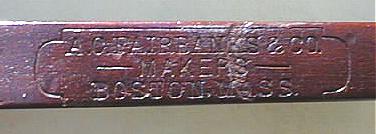
In 1890 Fairbanks and Cole parted ways, each forming
his
own company.
It was in 1890 that Fairbanks introduced his
revolutionary
new "Electric" model.
The Electric differed from the banjos of Fairbanks'
main
competitor, S.S. Stewart, by the addition
of a novel new tone ring (patent issued on Dec. 30,
1890).
The Electric tone ring
added a pronounced brilliance and sustain to the tone
of the banjo which is favored to this day.
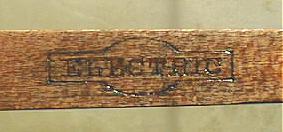
Fairbanks "Electric" Dowel Stick Stamp
|
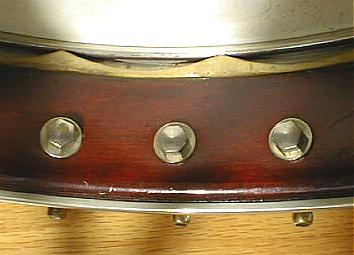
Early Fairbanks Electric tone ring
|
The renowned Electric tone ring consists of a
scalloped
metal truss which rests on the top of the wooden pot
and supports a round metal ring. In this early
version the entire metal assembly is contained in a
thin metal sheath which is then spun over the outside
of the pot as shown.
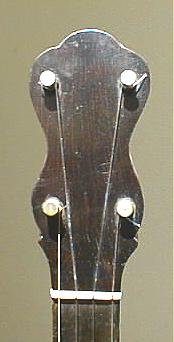
An interesting Fairbanks
peghead. They usually
have an additional point
on top.
|
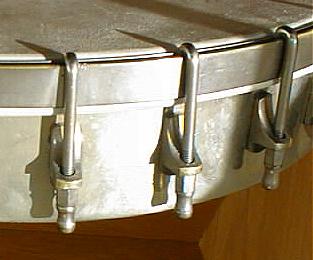
Typical early Fairbanks hardware on a full spun pot.
Note the groved tension hoop.
|
The Fairbanks company continued to produce a
"Fairbanks
& Cole" model until around 1897.
It was similar in appearance to the early Electrics,
but it had only a simple full-spun pot.
It was identified by the Fairbanks & Cole model
stamp
as well as the Fairbanks stamp.

The Fairbanks & Cole Model Stamp
|
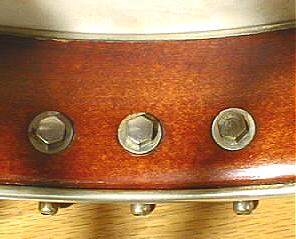
Fairbanks' Fairbanks & Cole Pot
|
The Fairbanks & Cole model shown here is typical
of
all early Fairbanks pots other than the various
Electric models. It is a simple wooden hoop with
the full spun metal sheath on the outside. The
top and bottom of the metal sheath contain thin metal
rings to add strength and to provide
a surface over which the metal sheath is formed.
The higher grades of banjos had hex bolts and
washers
securing the external brackets to
the pot. Lesser grades had slotted screws and
washers
as shown below.
An interesting variant of the Electric model was the
Curtis
Electric, named after Fairbanks'
son Curtis who was a child prodigy on the banjo.
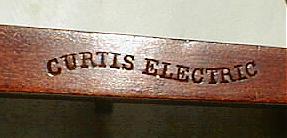
The Curtis Electric Dowel Stick Stamp
|
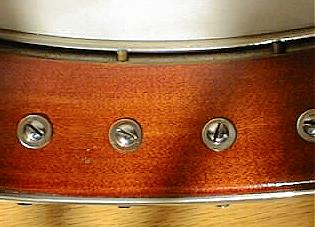
Curtis Electric Tone Ring
|
The Curtis Electric tone ring consists of a square
brass
ring, barely visible above, sitting on top
of the wooden hoop. Numerous brass rods extend
from the brass ring to the spun over round metal hoop
as in the standard Electric. The concepts are
similar,
but the significantly greater mass of the
standard Electric construction absorbs less of the
vibrations
of the skin and results in a much
more brilliant and projecting tone. The Curtis
Electric is, unfortunately, a rather poor playing banjo.
The Imperial and the "Fairbanks & Cole" models
were
continued during this period.
The F&C stamp was frequently accompanied by a
"Trade
Mark" stamp which consisted
of a star surrounded by the words TRADE MARK.
This
was possibly used to counter
Cole's arguments against the continued use of his name
on the Fairbanks banjos.
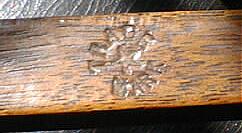
The Fairbanks models introduced during this early
period
were:
Electric - 1890
Curtis Electric - late 1890
Imperial Electric - 1891
Columbian - 1891
Senator - 1892
Special - 1894
Regent - 1895
|
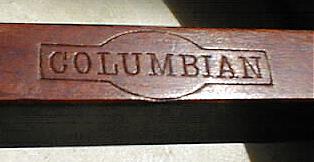 |
The non-Electric models were quite similar,
differing
only in their degree of ornamentation.
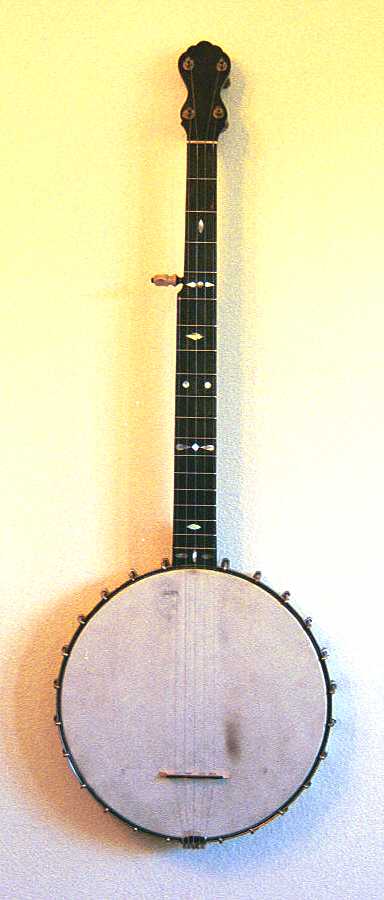 |
This is an 1895 Fairbanks Senator.
The full spun pot with its double rounded brackets and typical
early
style hooks and nuts is shown above.
Strung with light gauge steel strings, it is a fine old-time
player.
It was used for the song "I'm On My Way To Zion" on my "Notes Along The
Way" CD.
|

On to A.C.
Fairbanks
Co. (1895-1900)
- Return to main
Fairbanks
Banjos page -
Please contact
me with any additions, corrections or comments in general.
![]()











